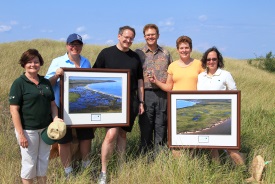Point Escuminac Nature Reserve

NCC staff and some members of the Maxfield family during a property visit, Point Escuminac, NB (Photo by Mike Dembeck)
A rare ecological treasure
Thanks to generous donations from the Maxfield family, the Nature Conservancy of Canada (NCC) has protected 326 hectares of ecologically significant land in Escuminac, about 55 kilometres east of Miramichi, New Brunswick.
These sites are situated on both sides of Point Escuminac on both Miramichi Bay and the Northumberland Strait. The Northumberland Strait is home to some of Atlantic Canada’s rarest habitats and species. NCC's Escuminac Nature Preserve began in 2013 and was completed in 2019, with the final donation of land, a 41-hectare coastal property at the mouth of Miramichi Bay. The nature preserve is located in an internationally recognized Important Bird Area, and provides vital breeding habitat for endangering piping plover. Bank swallow, listed as threatened under Canada's Species at Risk Act, nest in the peat cliffs. Other species found in the Escuminac area include common eider, common loon, black scoter, common goldeneye, long-tailed duck, American black duck, Canada goose, great blue heron and double-crested cormorant.
Donors
NCC wishes to recognize and thank the Maxfield family of the United States, for these gifts of land. Individual donations were received from Margaret Maxfield (mother) and her children, Daniel Maxfield, David (Kathy Becker) Maxfield, Elaine (J.D.) Starling and Nancy Novak.
The Maxfield family purchased the land in 1980 and used it as a summer place. Their father was a visiting professor at the University of New Brunswick in Fredericton and fell in love with the province. The Maxfields would pack their vehicle each summer and literally live off the beaches and land in this corner of eastern New Brunswick. Years later, having all grown up and living far away, the children wanted to see the site conserved.
“We want to remember this gorgeous piece of land and love it the way it was and has always been. To have the Nature Conservancy of Canada exist, where we can donate this property and feel like we are being good stewards without being here to be the good stewards because we can’t, and feel confident that it will remain as pristine as it was when were we were kids...it is a real blessing,” said David Maxfield.
(story continues below the video)
Conservation values
Point Escuminac is a very high priority area for NCC. It is one of the few remaining places where the nationally endangered piping plover can nest and raise its young without disturbance.
The Escuminac beaches provide critical habitat for 25 per cent of New Brunswick’s breeding population of piping plover. Rare peat cliffs can be found where the sea erodes the edge of an ancient 9,000-year-old coastal bog, exposing fossilized forests.
This diverse coastline includes forest, bog, salt marsh, sandy beach and eel-grass beds. It's also a birding paradise. Flocks of waterfowl congregate offshore, while bald eagle, osprey and marsh hawk cruise the open wetlands, and shorebirds feed and rest on the beach and in wetland pools.
Facts
- The conservation lands partially fall within the Escuminac Beaches Important Bird Area and two provincial Environmentally Significant Areas.
- Several of the properties front onto Miramichi Bay, which has one of the highest spring sea duck counts in the province.
- The properties feature an old eastern white cedar forest stand, along with pure softwood (spruce and fir or larch), mixed stands and pure hardwood stands. Dominant hardwood species include poplar, red maple and white birch.
- Ten provincially rare plant species are found on the properties, including Virginia chainfern, peach-leaved dock, swamp birch and white-fringed orchid.
Support
The Nature Conservancy of Canada wishes to recognize the following organizations for their financial support in completing the project:
- Government of Canada’s Natural Areas Conservation Program
- Enbridge Inc.
- U.S Fish and Wildlife Service, through the North American Wetlands Conservation Act
- American Friends of Canadian Nature
- Rayworth & Roberts Surveys Ltd.
- Crabtree Foundation
- New Brunswick Regional Development Corporation





